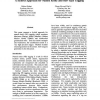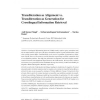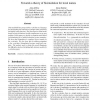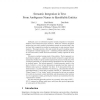1018 search results - page 8 / 204 » Generative unbinding of names |
ANLP
2000
13 years 9 months ago
2000
This paper presents a hybrid approach for named entity (NE) tagging which combines Maximum Entropy Model (MaxEnt), Hidden Markov Model (HMM) and handcrafted grammatical rules. Eac...
COLING
2010
13 years 2 months ago
2010
This paper proposes a method that leverages multiple machine translation (MT) engines for paraphrase generation (PG). The method includes two stages. Firstly, we use a multi-pivot...
TAL
2010
Springer
13 years 2 months ago
2010
Springer
Crosslingual Information Retrieval (CLIR) usually requires query translation and, due to named entities in the case of IR, query translation requires a good transliteration system ...
LICS
1999
IEEE
14 years 1 days ago
1999
IEEE
Pitts and Stark have proposed the -calculus as a language for investigating the interaction of unique name generation and higher-order functions. They developed a sound model base...
AIM
2005
13 years 7 months ago
2005
Intelligent access to information requires semantic integration of structured databases with unstructured textual resources. While the semantic integration problem has been widely...




